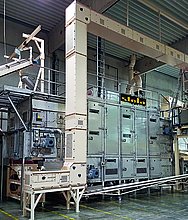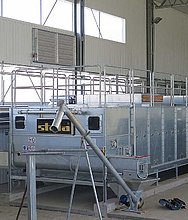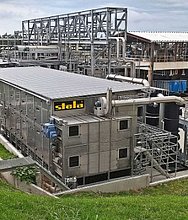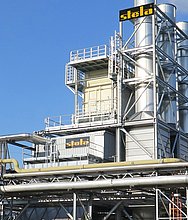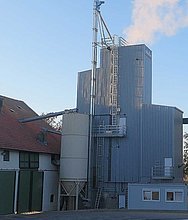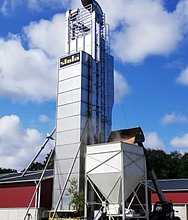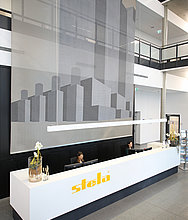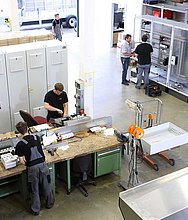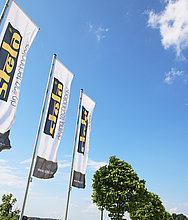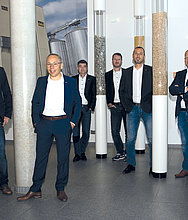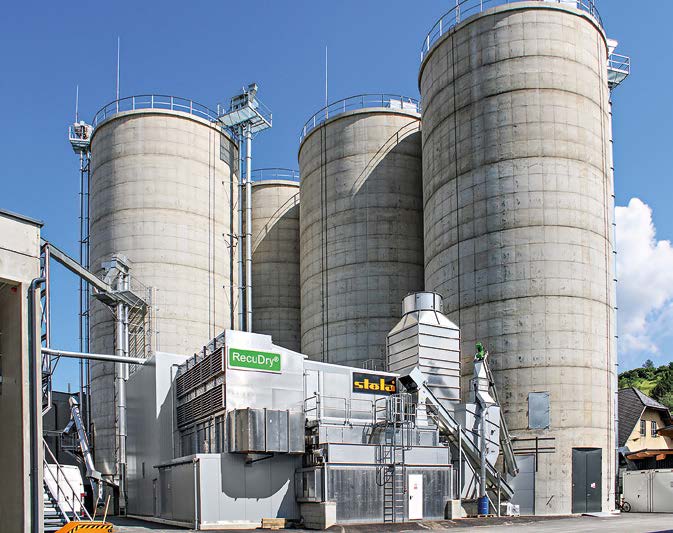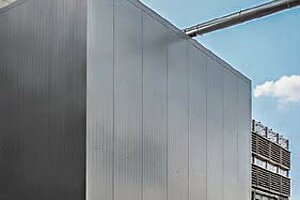Franz Moser – “Der Hackschnitzler”, Austria: stela belt dryer as a central part of a self-contained overall energy concept
Sawdust also wants to be dried appropriately before pelleting. Many producers, including newcomer Franz Moser, rely on the decades of expertise of stela Laxhuber, Massing/Germany. Thanks to a sophisticated heat recovery system, the new belt dryer is not only particularly energy-efficient but also virtually cleans itself thanks to special condensate treatment.
Since the beginning of the year, Franz Moser in Neumarkt in the Austrian province of Styria has been producing around 30,000 t/y of pellets from local energy and waste wood. "Our raw material supply is secure. 80% of our raw material comes from wood chips produced specifically for this purpose. Purchased chips, therefore, only play a subordinate role in our raw material supply," explains company founder Franz Moser. The forestry contractor entered the biomass business for the first time in 2007 and has since been producing around 2000 ster/day of woodchips from and for the region. Over the years, solid and cooperative relationships have developed with the surrounding forest farmers and forestry operations, which benefit Moser in an ever-worsening raw material situation. Since 2013, Moser has moved its business location opposite the Neumarkt railway station and thus directly next to the tracks. “In our business, we produce all year round. However, consumption concentrates on the winter months. This requires storage area,” informs the entrepreneur.
16,000 households in the final stage
Moser invested around € 20 million in the construction of its new pelletising plant. However, the entrepreneur in Austria is not alone in this. According to information from the interest group proPellets Austria, eleven new pellet plants are expected to start up by 2024 alone. Altogether, the industry is currently investing around € 250 million in the expansion of domestic energy supply through pellets. In the final expansion stage and at full capacity, Moser's pelletising plant could produce up to 90,000 t/y of pellets. This would correspond to the thermal heat demand of around 16,000 households. "However, we are already operating economically even under our current lower production volumes. Our goal is to grow on a sustainable base. Higher production volumes require more raw material and, above all, employees," says Moser, giving an insight into the company's growth strategies.
100% sustainable production
Moser began planning the new plant and the first supplier talks in the autumn of 2020. "In addition to Salmatec as a press and equipment supplier (see article on pages 16 to 17), it quickly became clear to us that we wanted to put our trust in stela Laxhuber when it came to drying," Moser recalls and adds: "Above all, the energy concept presented for the site completely convinced us." Moser invested in energy supply at the site even before the new pellet plant. A total of 1 MW of installed electrical power is already on the hall roofs in the form of PV systems. A further 1.35 MW or so will be added by twelve wood gasifiers. "We use all the waste heat from the wood gasifiers and CHP units in the system and feed it directly into our dryer. No valuable energy is thereby lost at the site. The entire energy cycle remains closed," explains Tobias Latein, Sales Manager at stela Laxhuber.
Energy
“Pelletising” is done during the week. However, the dryer runs around the clock so that the waste heat from the CHP is also consumed accordingly," informs Moser.
One third less energy consumption
The BTU type low-temperature belt dryer installed at Moser is equipped with stela's patented RecuDry technology. The heat recovery system has established itself at stela over the years and is already used in the majority of enquiries and projects: "The topic of energy is a key issue for all our customers. Our RecuDry system provides answers to questions about efficiency. More than 35% of the thermal energy demand is actively saved by our system with heat recovery," explains Latein. The evaporation capacity of the dryer at Moser is 3.5 t of water per hour. For comparison: without the RecuDry system, this value would be less than 2.2 t/hour – and that with the same heat requirement. "Of course, the investment in technology is accordingly higher. However, due to the significantly reduced energy consumption, it already pays for itself after two to three years," informs Latein.
Automatic cleaning increases performance and availability
A special feature is found in Moser's raw material. Not only does the Styrian use both wood chips and sawdust in different mixing ratios – at Moser, larch wood is also added to the pellets at a rate of around 10%. In a wet hammer mill, the entire material is first homogenised before it is evenly distributed via the intermediate step wet chip silo with the help of two distribution screws on the 6.2 m wide, perforated drying belt until the set bulk thickness is achieved. Inside the belt dryer, however, there are some technical refinements: One of these is the two-module principle of the drying system. In the RecuDry module, the drying air is saturated in the rear area of the dryer and then reused in the front area with the help of the condensation module to heat up the fresh air drawn in. This circulation of the drying air through a cross-flow heat exchanger is one of the main reasons for the particularly energy-efficient operation of the entire drying systems. A unique selling point of stela is also found in condensate treatment. The condensate, which is still acidic at the beginning, is neutralised in a compact system and treated with a biocide to prevent biotic activities. A belt filter cleans the liquid from suspended matter and other impurities. The cleaned condensate is then used to clean the heat recovery modules. "This process happens fully automatically without any manual intervention. The constant cleaning of the modules significantly improves performance on the one hand and increases availability on the other, as no cleaning breaks are necessary," says Latein, aware of the advantages of the stela feature.
Source: Holzkurier Issue 26 from 29/06/2023, Text and photos by Raphael Kerschbaumer











